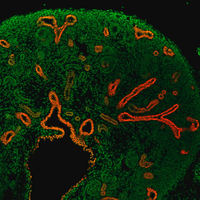MDC Researchers Uncover Regulatory Network in the Kidney

Kidney of a mouse embryo. The cell nuclei are stained green, the transcription factor Grhl2 red. (Photo: Katharina Walentin/ Copyright: MDC)
PhD student Annekatrin Aue, Dr. Christian Hinze and Professor Kai Schmidt-Ott of the Max Delbrück Center for Molecular Medicine (MDC) have now discovered how parts of these kidney tubules establish an inner space (lumen) and form a tight barrier against adjacent structures. The epithelial cells which line the tubules coordinate these processes through a novel molecular signaling pathway (Journal of the American Society of Nephrology, doi: 10.1681/ASN.2014080759)1.
The starting point of the MDC researcher's analyses was the transcription factor grainyhead-like 2 (Grhl2). As the research group led by Professor Schmidt-Ott discovered a few years ago, Grhl2 regulates the formation and structural integrity of epithelial cells lining the inner and outer surfaces of the body. Now, the researchers have shown that this gene regulator also plays a role in the kidney.
The studies, which were funded by the German Research Foundation (DFG) and the Urological Research Foundation, revealed that Grhl2 is primarily expressed in the renal collecting duct and in its embryonic precursors, the nephric duct and the ureteric bud. The collecting ducts form particularly tight, impermeable segments of the nephron, which is the basic structural unit of the kidney. The kidney filters around 1700 liters of blood every day, producing about 180 liters of primary urine.
However, after passing through the tubular system only one to two liters of urine are excreted, while the remaining vital components are reabsorbed. The collecting ducts carry out the fine-tuning of the urinary composition, thereby ensuring life-sustaining processes like blood pressure regulation and body water homeostasis.
To determine the function of the Grhl2 transcription factor in the kidney, the researchers investigated cell cultures of collecting duct cells and nephric ducts of mouse embryos deficient for this factor. The result: If Grhl2 is missing, the barrier function of these epithelial cells is significantly reduced and lumen expansion is defective.
Furthermore, the MDC researchers found that the transcription factor Grhl2 does not work alone. It teams up with and regulates another transcription factor, ovo-like 2 (Ovol2). This tandem controls a gene that is important for the sealing of epithelial cell clusters (claudin 4), thus ensuring an impermeable barrier, as well as another gene (Rab 25), which controls cellular trafficking of constituents between the cell and the internal environment of the lumen. Hence, the researchers could elucidate a novel molecular signaling pathway in the kidney.
Barrier formation and lumen expansion are essential components for normal kidney development and function. However, they also participate in kidney pathology, such as cystic kidney diseases, which lead to an uncontrolled expansion of the tubular lumen. Further research must demonstrate whether the insights obtained by the MDC researchers are of clinical importance.
1A Grainyhead-Like 2/Ovo-Like 2 Pathway Regulates Renal Epithelial Barrier Function and Lumen Expansion
Annekatrin Aue*†, Christian Hinze*‡, Katharina Walentin*, Janett Ruffert*, Yesim Yurtdas*§‖, Max Werth*, Wei Chen*, Anja Rabien§‖, Ergin Kilic¶, Jörg-Dieter Schulzke**, Michael Schumann** and Kai M. Schmidt-Ott*†‡
*Max Delbrueck Center for Molecular Medicine, Berlin, Germany
†Experimental and Clinical Research Center, and
Departments of ‡Nephrology, §Urology,
¶Pathology, and
**Gastroenterology, Charité Medical University, Berlin, Germany; and
‖Berlin Institute of Urologic Research, Berlin, Germany
#Corresponding author: Prof. Dr. Kai M. Schmidt-Ott, MDC, email: kai.schmidt-ott@charite.de
A micrograph of the kidney can be downloaded from the Internet at:
https://www.mdc-berlin.de/44046890/en/news/2015
Contact:
Barbara Bachtler
Press Department
Max Delbrück Center for Molecular Medicine (MDC) Berlin-Buch
in the Helmholtz Association
Robert-Rössle-Straße 10
13125 Berlin, Germany
Phone: +49 (0) 30 94 06 – 38 96
Fax: +49 (0) 30 94 06 – 38 33
e-mail: presse@mdc-berlin.de
http://www.mdc-berlin.de/en
https://www.mdc-berlin.de/44319749/en/news/2015/20150319-mdc_researchers_uncover…
Media Contact
All latest news from the category: Health and Medicine
This subject area encompasses research and studies in the field of human medicine.
Among the wide-ranging list of topics covered here are anesthesiology, anatomy, surgery, human genetics, hygiene and environmental medicine, internal medicine, neurology, pharmacology, physiology, urology and dental medicine.
Newest articles

A new look at the consequences of light pollution
GAME 2024 begins its experiments in eight countries. Can artificial light at night harm marine algae and impair their important functions for coastal ecosystems? This year’s project of the training…

Silicon Carbide Innovation Alliance to drive industrial-scale semiconductor work
Known for its ability to withstand extreme environments and high voltages, silicon carbide (SiC) is a semiconducting material made up of silicon and carbon atoms arranged into crystals that is…

New SPECT/CT technique shows impressive biomarker identification
…offers increased access for prostate cancer patients. A novel SPECT/CT acquisition method can accurately detect radiopharmaceutical biodistribution in a convenient manner for prostate cancer patients, opening the door for more…





















